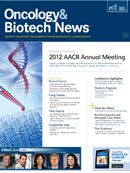Publication
Article
Oncology & Biotech News
Ingenol Mebutate Gel Is Effective and Safe for Actinic Keratosis
Author(s):
Field-directed treatment with the investigational topical agent ingenol mebutate has been shown to be effective for actinic keratoses on the head and body.
Mark Lebwohl, MD
Field-directed treatment with the investigational topical agent ingenol mebutate has been shown to be effective for actinic keratoses on the head and body, researchers reported. Actinic keratoses are a precursor to squamous cell carcinoma.
Ingenol mebutate is a macrocyclic diterpine ester derived from the plant Euphorbia peplus. It has long been used to treat common skin lesions, including cancerous lesions, the authors wrote.
Mark Lebwohl, MD, professor and chairman of the Department of Dermatology at Mount Sinai School of Medicine in New York City, and colleagues’ analysis of pooled data from four placebo-controlled studies also showed that treatment was safe, with local reactions usually of low-to-intermediate intensity and short duration.
The investigators randomized patients with actinic keratoses on the face, scalp, trunk, or extremities to receive ingenol mebutate or placebo self-applied to a 25-cm2 contiguous field once daily for 3 consecutive days for lesions on the face or scalp, or for 2 consecutive days for the trunk or extremities. A 0.015% concentration was applied to the face or scalp and a 0.05% concentration to the trunk or extremities.
The analysis included 1005 patients who were aged 18 years or older and had four to eight clinically typical, visible, and discrete actinic keratoses within a 25-cm2 contiguous field on the face or scalp or on the trunk or extremities. The primary efficacy endpoint was the complete clearance of all clinically visible actinic keratoses in the target treatment area on day 57.
In a pooled analysis of the two trials involving the face and scalp, the rate of complete clearance was 42.2% with ingenol mebutate versus 3.7% with placebo (P <.001). In a pooled analysis of the two trials involving the trunk and extremities, the rates of complete clearance were 34.1% and 4.7% for the two treatment arms, respectively (P <.001).
Local skin reactions peaked between days 3 and 8 and rapidly declined to near baseline by day 29. Adverse events were usually mild to moderate and resolved without complications.
Lebwohl et al noted that short exposure to ingenol mebutate offers two important benefits over current topical treatments: the relatively rapid resolution of local reactions and a nearly 100% rate of adherence to therapy.
Short exposure to ingenol mebutate offers two important benefits over current topical treatments: the relatively rapid resolution of local reactions and a nearly 100% rate of adherence to therapy.
Cryotherapy is the most popular lesion-directed therapy for actinic keratoses in the United States, the researchers noted. However, cryotherapy, as well as other locally ablative therapies, is limited by the potential for scarring coupled with high recurrence rates.
Currently available self-applied, topical field therapies require lengthy treatment, which may potentiate prolonged local reactions and, ultimately, poor treatment adherence.
Preclinical studies demonstrated that ingenol mebutate is a pleiotropic effector that promotes rapid and direct cell death and immune responses mediated by specific activation of protein kinase C delta.
Lebwohl M, Swanson N, Anderson LL, et al. Ingenol mebutate gel for actinic keratosis. N Engl J Med. 2012;366(11):1010-1019.










